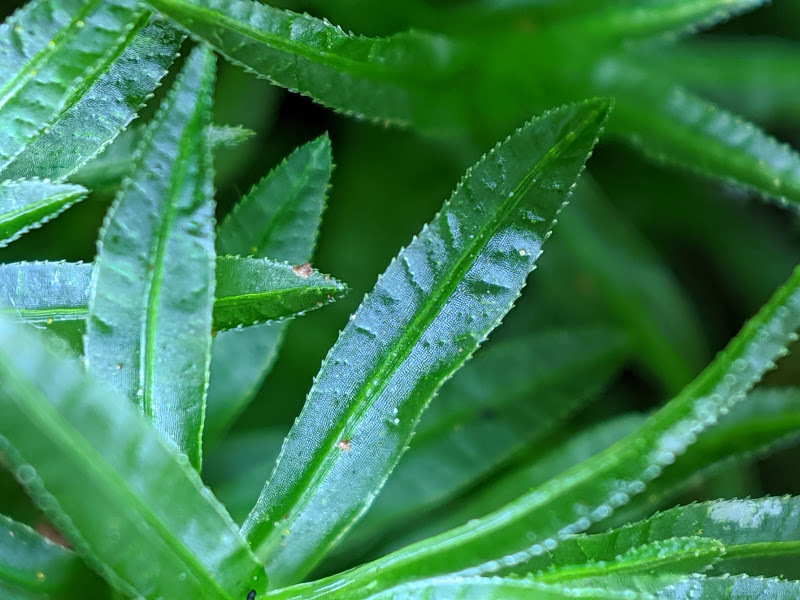Polytrichaceae
Dioicous or rarely monoicous (not in Victoria). Asexual propagules absent. Loose to dense tufts or scattered plants, sometimes on a persistent protonema (not in Victoria), on soil or less commonly rocks. Stems erect from a rhizome-like subterranean or creeping stem; aerial stems simple or rarely branched, often tall, to 65 cm, glabrous or with hyaline rhizoids toward the base; central strand present. Leaves arranged around the stem and facing all directions, scale-like toward stem base otherwise monomorphic, erect-spreading to squarrose when moist, appressed and straight, or incurved, crisped or contorted when dry, often with a strongly sheathing base, adaxially covered throughout except at margins with numerous closely packed rows of photosynthetic cells usually several cells tall (lamellae) that run longitudinally along the leaf, rarely lamellae few and confined to costa, or absent (not in Victoria); apex obtuse, acute or acuminate; costa narrow in sheathing base and becoming abruptly broadened and diffuse in spreading blade, or narrow throughout, percurrent or excurrent as a stout arista, with adaxial or rarely abaxial (not in Victoria) lamellae; margins entire to serrate, plane or incurved, unistratose, rarely bistratose or tristratose (not in Victoria), sometimes with a border of linear cells; laminal cells ovate, hexagonal or quadrate to rectangular, rectangular to linear in sheathing base, smooth or papillose (not in Victoria). Acrocarpous. Seta solitary or rarely more than one per perichaetium. Capsule erect to horizontal, terete or angled, symmetric or asymmetric, exserted, operculate. Calyptra mitrate or cucullate, rarely glabrous or apically serrate, often densely hairy, sometimes large and enveloping entire capsule. Operculum conic or rostrate. Peristome nematodontous, forming a single series of 16–64 teeth attached at their tips to a disc-like epiphragm that covers the capsule mouth, a white brush-like tuft of bristles, or rarely absent (not in Victoria).
Cosmopolitan, with 17 genera and around 200 species (Bell et al. 2021); seven genera and 13 species in Victoria.
The Polytrichaceae are a highly distinct family that are the sole representatives of an early diverging moss lineage that was likely to be the first to diverge from the lineage that contains all other peristomate mosses (Chang & Graham 2014). They have no close living relatives and greatly differ from other mosses morphologically as a result (Bippus et al. 2018). The complexity of both their gametophytes and sporophytes easily distinguishes them from other families. The gametophytes are often large, appearing like conifers seedlings, which in some taxa is permitted by conducting tissues in the stems comprising hydroids and leptoids (Hébant 1977). The tallest moss in the world, the Victorian Dawsonia superba Grev., belongs to this family and can reach 65 cm tall (van Zanten 1973). The leaves almost always have longitudinal rows or lamellae of photosynthetic cells stacked several cells high on the adaxial leaf surface that maximises photosynthesis in high light environments (Proctor 2005). The sporophyte also contains the conducting tissue of the gametophytes, and the peristome, when present, is formed by bundles of whole, thick-walled cells and are termed nematodontous, which differs from all other moss peristomes (arthrodontous) in Victoria that are just the remnants of cell walls (Shaw & Anderson 1988; Smith Merrill 2007; Chang & Graham 2014). Another early diverging lineage of mosses, the Tetraphidaceae, also have nematodontous peristomes but unlike the Polytrichaceae, form only four teeth, have developmental sequences more closely resembling arthrodontous peristomes than those of Polytrichaceae and are most likely to have evolved independently (Shaw & Anderson 1988; Bell & Hyvönen 2008).
Dawsonia have been treated in their own family based on their unique peristome of long white bristles (e.g. Scott & Stone 1976). In phylogenies of chloroplast and mitochondrial DNA sequences Dawsonia forms a lineage nested within the Polytrichaceae and so recognising it as its own family would render the remaining Polytrichaceae paraphyletic (Hyvönen et al. 2004; Bell & Hyvönen 2010). Retaining Dawsonia within Polytrichaceae can also be argued for on morphological grounds. The gametophytes of Dawsonia are almost indistinguishable from some genera of core Polytrichaceae. Consequently, Dawsonia is retained here within Polytrichaceae following van Zanten (1973).
 Spinning
SpinningBell, N.E.; Hyvönen, J. (2008). Rooting the Polytrichopsida: The phylogenetic position of Atrichopsis and the independent origin of the Polytrichopsid peristome, in Mohamed, H., Baki, B.B., Nasrulhaq-Boyce, A. & Lee, P.K.Y. (eds.), Bryology in the New Millennium, pp. 227–239. University of Malaya, Kuala Lumpur.
Bell, N.E.; Hyvönen, J. (2010). Phylogeny of the moss class Polytrichopsida (BRYOPHYTA): Generic-level structure and incongruent gene trees. Molecular Phylogenetics and Evolution 55: 381–398.
Bell, N.; Kariyawasam, I.; Flores, J.; Hyvönen, J. (2021). The diversity of the Polytrichopsida–a review. Bryophyte Diversity & Evolution 43: 98–111.
Bippus, A.C.; Escapa, I.E.; Tomescu, A.M.F. (2018). Wanted dead or alive (probably dead): Stem group Polytrichaceae. *American Journal of Botany * 105: 1243–1263.
Chang, Y.; Graham, S.W. (2014). Patterns of clade support across the major lineages of moss phylogeny. *Cladistics * 30: 590–606.
Hébant, C. (1977). The conducting tissues of bryophytes. Strauss and Cramer GmbH, Hirschberg, Germany.
Hyvönen, J.; Koskinen, S.; Smith Merrill, G.L.; Hedderson, T.A.; Stenroos, S. (2004). Phylogeny of the Polytrichales (Bryophyta) based on simultaneous analysis of molecular and morphological data. Molecular Phylogenetics and Evolution 31: 915–928.
Proctor, M.C.F. (2005). Why do Polytrichaceae have lamellae?. Journal of Bryology 27: 221–229.
Scott, G.A.M.; Stone, I.G. (1976). The mosses of Southern Australia. Academic Press, London, New York, San Francisco.
Shaw, J.; Anderson, L.E. (1988). Peristome development in mosses in relation to systematics and evolution. II. Tetraphis pellucida (Tetraphidaceae). American Journal of Botany 75: 1019–1032.
Smith Merrill, G.L. (2007). Polytrichaceae, in Flora of North America Editorial Committee (eds.), Flora of North America north of Mexico 27, pp. 121–126. Oxford University Press, Oxford, UK.
Zanten, B.O. van (1973). A taxonomic revision of the genus Dawsonia R.Brown. *Lindbergia * 2: 1–48.


